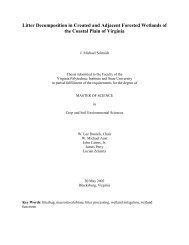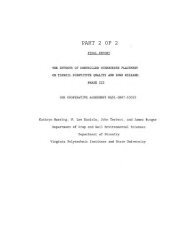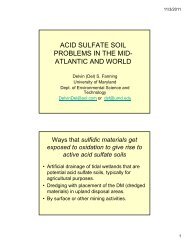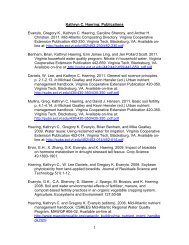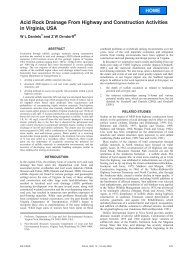Remediation of PAH-Contaminated Soils and Sediments: A ...
Remediation of PAH-Contaminated Soils and Sediments: A ...
Remediation of PAH-Contaminated Soils and Sediments: A ...
Create successful ePaper yourself
Turn your PDF publications into a flip-book with our unique Google optimized e-Paper software.
� Straube et al. (2003) showed that the introduction <strong>of</strong> Pseudomonas<br />
aeruginosa strain 64, a rhamnolipid-producing bacterium, enhanced the<br />
biodegradation <strong>of</strong> <strong>PAH</strong>s in highly contaminated soil.<br />
� Conte et al. (2005) found that humic acid can be used as an effective<br />
surfactant for <strong>PAH</strong> desorption.<br />
� Bogan <strong>and</strong> Sullivan (2003) reported that the addition <strong>of</strong> fulvic acid to soils<br />
that had low humic acid/fulvic acid content greatly enhanced pyrene<br />
mineralization by Mycobacterium austoafricanum. They also reported<br />
slower progress in <strong>PAH</strong> sequestration in a soil with high fulvic acid<br />
content.<br />
Cyclodextrins: Cyclodextrins are cyclic oligosaccharides that are able to form<br />
complexes with hydrophobic molecules. They are the product <strong>of</strong> the action <strong>of</strong><br />
cyclodextrin glycosytransferases on starch <strong>and</strong> are non-toxic <strong>and</strong> biodegradable<br />
in the environment. Cyclodextrins can be added to washing waters to solubilize<br />
<strong>PAH</strong>s <strong>and</strong> increase desorption from soil (Stokes et al., 2006).<br />
Vegetable oil: Vegetable oil has been proposed as an economic <strong>and</strong><br />
environmentally friendly solvent to dissolve <strong>PAH</strong>s <strong>and</strong> has been shown to be as<br />
effective as organic solvents like acetone <strong>and</strong> dichloromethane (Gong et al.,<br />
2005).<br />
Bioreactors<br />
Treatment <strong>of</strong> contaminated sediments in a slurry phase is completed in a<br />
bioreactor. Advantages <strong>of</strong> the slurry phase include: complete mixing <strong>of</strong> nutrients<br />
into sediment, increased contact between microorganism <strong>and</strong> contaminant,<br />
control (Eweis et al., 1998). Bioreactors are commercially available for this type<br />
<strong>of</strong> treatment but are expensive. Sediment is <strong>of</strong>ten put into the bioreactors in<br />
small batches; however, continuous flow operations are possible. With<br />
treatment, the slurry is mixed with nutrients <strong>and</strong> microbial cultures <strong>and</strong> aerated.<br />
The sediment then settles <strong>and</strong> the water is transferred to a treatment plant while<br />
the sediment is returned to a contained area (Eweis et al., 1998). For large<br />
quantities <strong>of</strong> sediment, this is a difficult option.<br />
59



